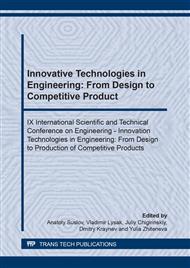[1]
M. Bichler, Parts from Plastmass - Cast without defects, Heidelberg: Tsechner, Speyer, 1999, p.112.
Google Scholar
[2]
N.S. Lubimyi, M.S. Chepchurov, B.S. Chetverikov, N.A. Tabekina, E.I. Evtushenko, The technological heredity in the manufacture of the metal-polymeric build-forming molds, ARPN Journal of Engineering and Applied Sciences 11:20 (2016) 12302-12310.
Google Scholar
[3]
N.S. Lubimyi, M.S. Chepchurov, E.I. Evtushenko, Thermostating calculation for combined metal-metal polymer press mold for plastic casting, International Journal of Pharmacy & Technology 8:4 (2016) 24889-24899.
Google Scholar
[4]
Filatov, V.I. Technologicheskaya podgatovka protsessov formovaniya izdeliy' iz plast mass / V.I. Filatov, V.D. Korsakov. - L .: Politechnika, 1991. - 352 p.
Google Scholar
[5]
M.V. Fabretto, D.R. Evans, M. Mueller, K. Zuber et al., Polymeric Material with Metal-Like Conductivity for Next Generation Organic Electronic Devices, Chemistry of Materials 24 (2012) 3998-4003.
DOI: 10.1021/cm302899v
Google Scholar
[6]
Y. Xia, K. Sun, J. Ouyang, Solution–processed metallic conducting polymer films as transparent electrode of optoelectronic devices, Adv. Mater 24 (2012) 2436–2440.
DOI: 10.1002/adma.201104795
Google Scholar
[7]
Pryamye izmereniya s mnogokratnymi nablyudeniyami (Direct measurements with multiple observations), GOST 8.207-76 IGG.
Google Scholar
[8]
Normiruemye kharakteristiki sredstv izmereniya (Normalized characteristics of measuring instruments), GOST 8.0009-84 IGG.
Google Scholar
[9]
A.D. Myshkis, Elementy teorii matematicheskikh modeley (The elements of mathematical theory and modeling), M.: KomKniga, 2007, p.192.
Google Scholar
[10]
A.P. Babichev, N.A. Babushkina, A.M. Bratkovskiy et. al., Fizicheskiye velichiny: spravochnik (Physical Values: Reference Book), in I.S. Grigor'yeva, Ye.Z. Meylikhova (Eds.), M.: Energoatomizdat, 1991, p.1232.
Google Scholar
[11]
E.F. Dolinskiy, Obrabotka rezul'tatov izmereniy (Calculation and Report), M.: Izd-vo standartov, 1973, p.192.
Google Scholar
[12]
A.G. Korotkikh, Teploprovodnost' materialov: uchebnoye posobiye (Thermal Conductivity of Material: Student's book), Tomsk Polytechnic University, 2011, p.97.
Google Scholar
[13]
A.F. Boyko, E.Y. Kudenkov, Tochnyy metod rascheta neobkhodimogo kolichestva povtornykh opytov (Precise technique for calculating a required number of replicated experiments), Vestnik Belgorodskogo gosudarstvennogo tekhnologicheskogo universiteta im. V.G. Shukhova (Bulletin of Belgorod State Technological University named after V.G. Shukhov) 8 (2016) 128–132.
DOI: 10.17277/vestnik.2016.03.pp.420-426
Google Scholar
[14]
Statisticheskiye metody. Rukovodstvo po primeneniyu v sootvetstvii s GOST R ISO 9001 (Statistical methods: Manual instructions in accordance with GOST R ISO 9001), M.: Standartinform, GOST R ISO/TO 10017-2005. (2005).
DOI: 10.14489/hb.2014.07.pp.057-064
Google Scholar
[15]
C. Bunks, J.P. Chancelier, F. Delebecque et. al., Engineering and Scientific Computing with Scilab, C. Gomez, Ed. Boston, Basel, Berlin: Birkh¨auser, (1998).
DOI: 10.1007/978-1-4612-1584-4
Google Scholar
[16]
Scilab Enterprises. Scilab: Free and Open Source software for numerical computation (OS, Version 5.5.2), 2012, Information on http://www.scilab.org.
Google Scholar


